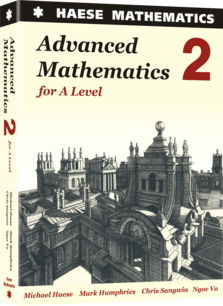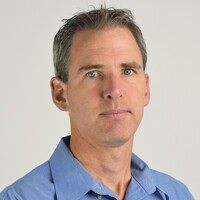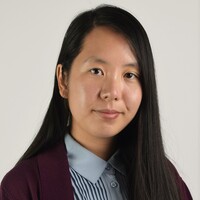About the Book
Year Published: 2017
Page Count: 524
ISBN: 978-1-925489-32-3 (9781925489323)
Online ISBN: 978-1-925489-33-0 (9781925489330)

Discontinued Editions
Year Published: 2017
Page Count: 524
ISBN: 978-1-925489-32-3 (9781925489323)
Online ISBN: 978-1-925489-33-0 (9781925489330)
| SYMBOLS AND NOTATION USED IN THIS BOOK | 10 | ||
| 1 | SEQUENCES AND SERIES | 13 | |
| A | Number sequences | 14 | |
| B | Arithmetic sequences | 17 | |
| C | Geometric sequences | 21 | |
| D | Applications of geometric sequences | 24 | |
| E | Series | 27 | |
| F | Arithmetic series | 30 | |
| G | Geometric series | 33 | |
| H | The binomial expansion | 39 | |
| Review set 1A | 45 | ||
| Review set 1B | 46 | ||
| 2 | FUNCTIONS | 49 | |
| A | Composite functions | 50 | |
| B | Inverse functions | 53 | |
| C | Partial fractions | 59 | |
| Review set 2A | 61 | ||
| Review set 2B | 62 | ||
| 3 | THE UNIT CIRCLE AND RADIAN MEASURE | 63 | |
| A | Radian measure | 64 | |
| B | Arc length and sector area | 67 | |
| C | The unit circle and the trigonometric ratios | 70 | |
| D | Multiples of pi/6 and pi/4 | 73 | |
| E | Finding trigonometric ratios | 76 | |
| F | Finding angles | 77 | |
| G | Small angle approximations | 78 | |
| Review set 3A | 80 | ||
| Review set 3B | 81 | ||
| 4 | TRIGONOMETRIC FUNCTIONS | 83 | |
| A | The sine and cosine functions | 85 | |
| B | The tangent function | 92 | |
| C | Reciprocal trigonometric functions | 95 | |
| D | Inverse trigonometric functions | 97 | |
| E | Trigonometric equations | 100 | |
| F | Trigonometric models | 105 | |
| Review set 4A | 109 | ||
| Review set 4B | 110 | ||
| 5 | TRIGONOMETRIC IDENTITIES | 113 | |
| A | Algebra with trigonometric functions | 114 | |
| B | Double angle identities | 118 | |
| C | Angle sum and difference identities | 122 | |
| Review set 5A | 130 | ||
| Review set 5B | 131 | ||
| 6 | REASONING AND PROOF | 133 | |
| A | Proof by contrapositive | 135 | |
| B | Proof by contradiction: reductio ad absurdum | 137 | |
| C | Fermat's method of infinite descent | 140 | |
| Review set 6A | 142 | ||
| Review set 6B | 142 | ||
| 7 | DIFFERENTIAL CALCULUS | 143 | |
| A | First principles | 144 | |
| B | Simple rules of differentiation | 148 | |
| C | The chain rule | 151 | |
| D | The product rule | 155 | |
| E | The quotient rule | 157 | |
| F | Derivatives of exponential functions | 160 | |
| G | Derivatives of logarithmic functions | 164 | |
| H | Derivatives of trigonometric functions | 167 | |
| I | Second derivatives | 170 | |
| J | Implicit differentiation | 171 | |
| Review set 7A | 175 | ||
| Review set 7B | 176 | ||
| 8 | APPLICATIONS OF DIFFERENTIAL CALCULUS | 179 | |
| A | Tangents and normals | 180 | |
| B | Increasing and decreasing | 186 | |
| C | Stationary points | 189 | |
| D | Shape | 191 | |
| E | Inflection points | 192 | |
| F | Rates of change | 198 | |
| G | Optimisation | 202 | |
| H | Related rates | 206 | |
| Review set 8A | 210 | ||
| Review set 8B | 213 | ||
| 9 | INTEGRATION | 217 | |
| A | Integration | 220 | |
| B | Rules for integration | 222 | |
| C | Particular values | 226 | |
| D | Integrating f(ax + b) | 227 | |
| E | Definite integrals | 231 | |
| Review set 9A | 235 | ||
| Review set 9B | 236 | ||
| 10 | TECHNIQUES FOR INTEGRATION | 237 | |
| A | Partial fractions | 238 | |
| B | Integration by substitution | 240 | |
| C | Integration by parts | 246 | |
| Review set 10A | 248 | ||
| Review set 10B | 249 | ||
| 11 | APPLICATIONS OF INTEGRATION | 251 | |
| A | The area under a curve | 252 | |
| B | The area above a curve | 257 | |
| C | The area between two functions | 260 | |
| D | Problem solving by integration | 263 | |
| Review set 11A | 267 | ||
| Review set 11B | 268 | ||
| 12 | DIFFERENTIAL EQUATIONS | 271 | |
| A | Differential equations | 272 | |
| B | Differential equations of the form dy/dx = f(x) | 275 | |
| C | Separable differential equations | 279 | |
| D | Logistic growth | 285 | |
| Review set 12A | 289 | ||
| Review set 12B | 290 | ||
| 13 | NUMERICAL METHODS | 293 | |
| A | Changes of sign methods for f(x) = 0 | 294 | |
| B | Cobweb and staircase diagrams for f(x) = 0 | 299 | |
| C | Newton-Raphson method for f(x) = 0 | 302 | |
| D | Numerical integration | 304 | |
| Review set 13A | 310 | ||
| Review set 13B | 311 | ||
| 14 | VECTORS | 313 | |
| A | Vectors in space | 315 | |
| B | Operations with vectors in space | 317 | |
| C | Vector algebra | 319 | |
| D | The vector between two points | 320 | |
| E | Parallelism | 324 | |
| F | Proof using vector geometry | 327 | |
| G | Lines in 2 and 3 dimensions | 328 | |
| H | Constant velocity problems | 332 | |
| I | Parametric equations | 333 | |
| J | Bézier curves | 338 | |
| Review set 14A | 341 | ||
| Review set 14B | 342 | ||
| 15 | KINEMATICS | 345 | |
| A | Motion in a straight line | 346 | |
| B | Projectile motion | 355 | |
| Review set 15A | 364 | ||
| Review set 15B | 365 | ||
| 16 | MECHANICS: FORCES AND MOMENTS | 367 | |
| A | Forces at a point | 369 | |
| B | Equilibrium | 371 | |
| C | Resolving forces | 374 | |
| D | Connected particles | 378 | |
| E | Friction | 381 | |
| F | Moments | 384 | |
| G | Couples | 388 | |
| H | Synoptic problems | 392 | |
| Review set 16A | 394 | ||
| Review set 16B | 396 | ||
| 17 | PROBABILITY | 399 | |
| A | Two-way tables | 401 | |
| B | Conditional probability | 402 | |
| C | The product rule of probability | 405 | |
| D | Tree diagrams | 408 | |
| Review set 17A | 412 | ||
| Review set 17B | 413 | ||
| 18 | THE NORMAL DISTRIBUTION | 415 | |
| A | The normal distribution | 417 | |
| B | Calculating probabilities | 420 | |
| C | The standard normal distribution | 429 | |
| D | Quantiles | 433 | |
| Review set 18A | 439 | ||
| Review set 18B | 441 | ||
| 19 | STATISTICAL HYPOTHESIS TESTING | 443 | |
| A | The Central Limit Theorem | 444 | |
| B | Hypothesis testing for a population mean (Z-test) | 450 | |
| C | Critical regions | 457 | |
| D | Correlation coefficients | 460 | |
| Review set 19A | 464 | ||
| Review set 19B | 465 | ||
| ANSWERS | 467 | ||
| INDEX | 522 | ||

Michael completed a Bachelor of Science at the University of Adelaide, majoring in Infection and Immunity, and Applied Mathematics. He studied laminar heat flow as part of his Honours in Applied Mathematics, and finished a PhD in high speed fluid flows in 2001. He has been the principal editor for Haese Mathematics since 2008.
What motivates you to write mathematics books?
My passion is for education as a whole, rather than just mathematics. In Australia I think it is too easy to take education for granted, because it is seen as a right but with too little appreciation for the responsibility that goes with it. But the more I travel to places where access to education is limited, the more I see children who treat it as a privilege, and the greater the difference it makes in their lives. But as far as mathematics goes, I grew up with mathematics textbooks in pieces on the kitchen table, and so I guess it continues a tradition.
What do you aim to achieve in writing?
I think a few things:
What interests you outside mathematics?
Lots of things! Horses, show jumping and course design, alpacas, badminton, running, art, history, faith, reading, hiking, photography ....

Mark has a Bachelor of Science (Honours), majoring in Pure Mathematics, and a Bachelor of Economics, both of which were completed at the University of Adelaide. He studied public key cryptography for his Honours in Pure Mathematics. He started with the company in 2006, and is currently the writing manager for Haese Mathematics.
What got you interested in mathematics? How did that lead to working at Haese Mathematics?
I have always enjoyed the structure and style of mathematics. It has a precision that I enjoy. I spend an inordinate amount of my leisure time reading about mathematics, in fact! To be fair, I tend to do more reading about the history of mathematics and how various mathematical and logic puzzles work, so it is somewhat different from what I do at work.
How did I end up at Haese Mathematics?
I was undertaking a PhD, and I realised that what I really wanted to do was put my knowledge to use. I wanted to pass on to others all this interesting stuff about mathematics. I emailed Haese Mathematics (Haese and Harris Publications as they were known back then), stating that I was interested in working for them. As it happened, their success with the first series of International Baccalaureate books meant that they were looking to hire more people at the time. I consider myself quite lucky!
What are some interesting things that you get to do at work?
On an everyday basis, it’s a challenge (but a fun one!) to devise interesting questions for the books. I want students to have questions that pique their curiosity and get them thinking about mathematics in a different way. I prefer to write questions that require students to demonstrate that they understand a concept, rather than relying on rote memorisation.
When a new or revised syllabus is released for a curriculum that we write for, a lot of work goes into devising a structure for the book that addresses the syllabus. The process of identifying what concepts need to be taught, organising those concepts into an order that makes sense from a teaching standpoint, and finally sourcing and writing the material that addresses those concepts is very involved – but so rewarding when you hold the finished product in your hands, straight from the printer.
What interests you outside mathematics?
Apart from the aforementioned recreational mathematics activities, I play a little guitar, and I enjoy playing badminton and basketball on a social level.

Chris completed a BA in Mathematics at the University of Oxford, and an MSc and PhD in Mathematics at the University of Bath. He spent thirteen years in the Mathematics Department at the University of Birmingham, and from 2000-2011 was seconded half time to the UK Higher Education Academy “Maths Stats and OR Network“ to promote learning and teaching of university mathematics. He was awarded a National Teaching Fellowship in 2006. Chris Sangwin joined the University of Edinburgh in 2015 as Professor of Technology Enhanced Science Education.
What are your learning and teaching interests in mathematics?
I teach mathematics at university but am particularly interested in core pure mathematics which starts in school and continues to be taught at university. Solving mathematical problems is at the heart of mathematics, and I enjoy teaching problem solving at university.
What interests you outside mathematics?
I really enjoy hill walking and mountaineering, particularly spending time with friends in the hills.
Why do you choose to collaborate with a small publisher on the other side of the world?
There is a unique team spirit in Haese which other publishers don't have. This makes authorship much more collaborative than my previous experiences, which is really enjoyable and I'm sure leads to much better quality books for students which are, after all, the whole point.

Ngoc Vo completed a Bachelor of Mathematical Sciences at the University of Adelaide, majoring in Statistics and Applied Mathematics. Her Mathematical interests include regression analysis, Bayesian statistics, and statistical computing. Ngoc has been working at Haese Mathematics as a proof reader and writer since 2016.
What drew you to the field of mathematics?
Originally, I planned to study engineering at university, but after a few weeks I quickly realised that it wasn't for me. So I switched to a mathematics degree at the first available opportunity. I didn't really have a plan to major in statistics, but as I continued my studies I found myself growing more fond of the discipline. The mathematical rigor in proving distributional results and how they link to real-world data -- it all just seemed to click.
What are some interesting things that you get to do at work?
As the resident statistician here at Haese Mathematics, I get the pleasure of writing new statistics chapters and related material. Statistics has always been a challenging subject to both teach and learn, however it doesn't always have to be that way. To bridge that gap, I like to try and include as many historical notes, activities, and investigations as I can to make it as engaging as possible. The reasons why we do things, and the people behind them are often important things we forget to talk about. Statistics, and of course mathematics, doesn't just exist within the pages of your textbook or even the syllabus. There's so much breadth and depth to these disciplines, most of the time we just barely scratch the surface.
What interests you outside mathematics?
In my free time I like studying good typography and brushing up on my TeX skills to become the next TeXpert. On the less technical side of things, I also enjoy scrapbooking, painting, and making the occasional card.
A complete electronic copy of the textbook, with interactive, animated, and/or printable extras.
Animated worked examples with step-by-step, voiced explanations.
Sample questions associated with each examination board's large data set(s) are included.
Graphics Calculator Instructions
For Casio fx-9860G Plus, Casio fx-CG20, TI-84 Plus CE, and Casio fx-991EX
Graphics calculator instructions for Casio fx-9860G Plus, Casio fx-CG20, TI-84 Plus CE, and Casio fx-991EX are included with this textbook. The textbook will either have comprehensive instructions at the start of the book, specific instructions available from icons located throughout, or both. The extensive use of graphics calculators and computer packages throughout the book enables students to realise the importance, application, and appropriate use of technology.

This book is available on electronic devices through our Snowflake learning platform. This book includes 27 months of Snowflake access, featuring a complete electronic copy of the textbook.
Where relevant, Snowflake features include interactive geometry, graphing, and statistics software, demonstrations, games, spreadsheets, and a range of printable worksheets, tables, and diagrams. Teachers are provided with a quick and easy way to demonstrate concepts, and students can discover for themselves and re-visit when necessary.
AS and A Level Mathematics specifications require students to become familiar with one or more specified large data sets.
It is important that students explore the data set(s) during the course of their study, so that they are aware of the terminology and contexts relating to the data.
In the final examination, students will be required to answer questions based on selected data or summary statistics from the large data set(s). Students who are familiar with the context and structure of the large data set(s) will be more able to engage in realistic interpretation in an examination setting.
Sample questions associated with each examination board's large data set(s) are accessible in the digital copy of the book.
This book offers SELF TUTOR for every worked example. On the electronic copy of the textbook, access SELF TUTOR by clicking anywhere on a worked example to hear a step-by-step explanation by a teacher. This is ideal for catch-up and revision, or for motivated students who want to do some independent study outside school hours.
Register your interest for information related to Haese Mathematics products